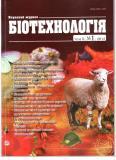ISSN 1995-5537

"Biotechnology" journal V. 5, No. 1, 2012
Р. 115-120, Bibliography 16, Ukrainian.
Universal Decimal classification: 575.862:547.583:581.526.52
T. O. Palladina, Zh. I. Ribchenko, O. O. Konturska
Kholodny Institute of Botany of National Academy of Sciences of Ukraine
Adaptogenic ability of Methyure preparation (2-thio-6-methyl-4-hydroxypyrimidine) has been studied by means of comparison with its structure analogs without using of lateral groups and Ivin preparation (N-oxide-2,4-dimethylpyrimidine) in salting conditions. Investigation was carried out with corn seedlings grown in water culture. Preparations have been used by seeds soaking in 10–7 M aqueuos solutions during twenty-four hours. Exposition of seedlings in 0.1 M NaCl inhibited hardly their growth, especially shoots, that was heighten as time of exposure extended. All of the preparations inhibited seedling growth due to salinification. Moreover effect of Methyure was directed mainly to roots as mass concentration. Preparation with only side mercapto group increased mass enrichment of aerial part of yet preparation with only methyl group resulted in elongation of both parts of germinants. Preparation without side groups had some growth stimulation effect as well. It demonstrated that pyrimidine ring played a functional role. Thus mercapto group promoted mass increasing, methyl group foster elongation of seedlings and both this groups ensured the preference of Methyure. Prolongation of term exposition from 1 to 10 days preserved growth effect only in preparation with lateral mercapto group. It was found out that presence of lateral mercapto groups in preparation caused antioxidant activity in vitro according with antiradical mechanism. Unlike Methyure, Ivine forvards growth only of shoots.
Obtained results demonstrated a significant role of lateral groups in adaptogenic effect of Methyure.
Key words: bioactive preparation, chemical structure, stress, antioxidative activity.
© Palladin Institute of Biochemistry of National Academy of Sciences of Ukraine, 2008

